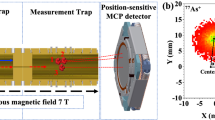Abstract
The tetraneutron has attracted the attention of nuclear physicists during the past decades, but there is still no unambiguous confirmation of its existence or non-existence. A new experiment based on \(^{8}\)He(p, 2p)\(^{7}\)H{t+\(^{4}n\)} reaction, with direct detection of the four neutrons, has been carried out at RIBF, which can hopefully help to draw a definite conclusion on the tetraneutron system.



Similar content being viewed by others
References
P.B. Demorest, T. Pennucci, S.M. Ransom, M.S. Roberts, J.W. Hessels, A two-solar-mass neutron star measured using Shapiro delay. Nature 467, 1081–3 (2010)
B.A. Brown, Neutron radii in nuclei and the neutron equation of state. Phys. Rev. Lett. 85, 5296–5299 (2000)
F.M. Marqués, J. Carbonell, The quest for light multineutron systems. Eur. Phys. J. A 57, 105 (2021)
K. Kisamori et al., Candidate resonant tetraneutron state populated by the \({}^{4}\)He(\({}^{8}\)He,\({}^{8}\)Be) reaction. Phys. Rev. Lett. 116, 052501 (2016)
F.M. Marqués et al., Detection of neutron clusters. Phys. Rev. C 65, 044006 (2002)
Marqués, F.M., et al., On the Possible Detection of \(^{4}\)n Events in the Breakup of \(^{14}\)Be (2005). arXiv:nucl-ex/0504009
S.C. Pieper, Can modern nuclear hamiltonians tolerate a bound tetraneutron? Phys. Rev. Lett. 90, 252501 (2003)
S. Gandolfi et al., Is a trineutron resonance lower in energy than a tetraneutron resonance? Phys. Rev. Lett. 118, 232501 (2017)
A.M. Shirokov et al., Prediction for a four-neutron resonance. Phys. Rev. Lett. 117, 182502 (2016)
K. Fossez et al., Can tetraneutron be a narrow resonance? Phys. Rev. Lett. 119, 032501 (2017)
J.G. Li et al., Ab initio no-core Gamow shell-model calculations of multineutron systems. Phys. Rev. C 100, 054313 (2019)
R. Lazauskas, J. Carbonell, Is a physically observable tetraneutron resonance compatible with realistic nuclear interactions? Phys. Rev. C 72, 034003 (2005)
A. Deltuva, Tetraneutron: rigorous continuum calculation. Phys. Lett. B 782, 238–241 (2018)
A. Deltuva, R. Lazauskas, Tetraneutron resonance in the presence of a dineutron. Phys. Rev. C 100, 044002 (2019)
E. Hiyama, R. Lazauskas, J. Carbonell, M. Kamimura, Possibility of generating a 4-neutron resonance with a \(T\)=3/2 isospin 3-neutron force. Phys. Rev. C 93, 044004 (2016)
M.D. Higgins et al., Nonresonant density of states enhancement at low energies for three or four neutrons. Phys. Rev. Lett. 125, 052501 (2020)
M.D. Higgins et al., Comprehensive study of the three- and four-neutron systems at low energies. Phys. Rev. C 103, 024004 (2021)
A.A. Korsheninnikov et al., Experimental evidence for the existence of \(^{7}\)H and for a specific structure of \({}^{8}\)He. Phys. Rev. Lett. 90, 082501 (2003)
M. Caamaño et al., Resonance state in \({}^{7}\)H. Phys. Rev. Lett. 99, 062502 (2007)
A.A. Bezbakh et al., Evidence for the first excited state of \(^{7}\)H. Phys. Rev. Lett. 124, 022502 (2020)
L.V. Grigorenko et al., Two-neutron radioactivity and four-nucleon emission from exotic nuclei. Phys. Rev. C 84, 021303(R) (2011)
K. Kusaka et al., Prototype of superferric quadrupole magnets for the BigRIPS separator at RIKEN. IEEE Trans. Appl. Supercond. 14, 310–315 (2004)
A. Obertelli et al., MINOS: A vertex tracker coupled to a thick liquid-hydrogen target for in-beam spectroscopy of exotic nuclei. Eur. Phys. J. A 50, 8 (2014)
S. Takeuchi et al., A NaI(Tl) detector array for measurements of \(\gamma \) rays from fast nuclei. Nucl. Instrum. Methods Phys. Res. Sect. A 763, 596–603 (2014)
Y. Shimizu et al., Vacuum system for the SAMURAI spectrometer. Nucl. Instrum. Methods Phys. Res. Sect. B 317, 739 (2013)
T. Kobayashi et al., SAMURAI spectrometer for RI beam experiments. Nucl. Instrum. Methods Phys. Res. Sect. B 317, 294–304 (2013)
S.W. Huang et al., Experimental study of \(^{4}n\) with \(^{8}\)He(\(p,2p\)) reaction. J. Phys.: Conf. Ser. 1643, 012090 (2020)
T. Aumann et al., Technical Report for the design, construction and commissioning of NeuLAND: The high-resolution neutron time-of-flight spectrometer for R\(^{3}\)B. Technical Report GSI and Collaborators (2011)
T. Nakamura, Y. Kondo, Large acceptance spectrometers for invariant mass spectroscopy of exotic nuclei and future developments. Nucl. Instrum. Methods Phys. Res. Sect. B 376, 156–161 (2016)
Z.X. Cao et al., Recoil proton tagged knockout reaction for \(^{8}\)He. Phys. Lett. B 707, 46–51 (2012)
K. Markenroth et al., \(^{8}\)He-\(^{6}\)He: a comparative study of nuclear fragmentation reactions. Nucl. Phys. A 679, 462–480 (2001)
Z.H. Yang et al., Quasifree neutron knockout reaction reveals a small \(s\)-orbital component in the borromean nucleus \(^{17}\)B. Phys. Rev. Lett. 126, 082501 (2021)
Y. Kondo et al., Recent progress and developments for experimental studies with the SAMURAI spectrometer. Nucl. Instrum. Methods Phys. Res. Sect. B 463, 173–178 (2020)
X. Mougeot et al., New excited states in the halo nucleus \(^{6}\)He. Phys. Lett. B 718, 441–446 (2012)
Acknowledgements
We acknowledge the support of the RIBF accelerator staff and the BigRIPS team for providing the high-quality beam. Z. H. Yang acknowledges the financial support from the Foreign Postdoctoral Researcher program of RIKEN. T. Aumann acknowledges the support by DFG via SFB 1245. P. Koseoglou acknowledges the support from BMBF (NUSTAR.DA grant No.05P 15RDFN1). S. Paschalis acknowledges the support of the UK STFC under contract numbers ST/L005727/1 and ST/P003885/1.
Author information
Authors and Affiliations
Corresponding author
Additional information
Publisher's Note
Springer Nature remains neutral with regard to jurisdictional claims in published maps and institutional affiliations.
Rights and permissions
About this article
Cite this article
Huang, S.W., Yang, Z.H., Marqués, F.M. et al. Experimental Study of \(^{4}n\) by Directly Detecting the Decay Neutrons. Few-Body Syst 62, 102 (2021). https://doi.org/10.1007/s00601-021-01691-4
Received:
Accepted:
Published:
DOI: https://doi.org/10.1007/s00601-021-01691-4




